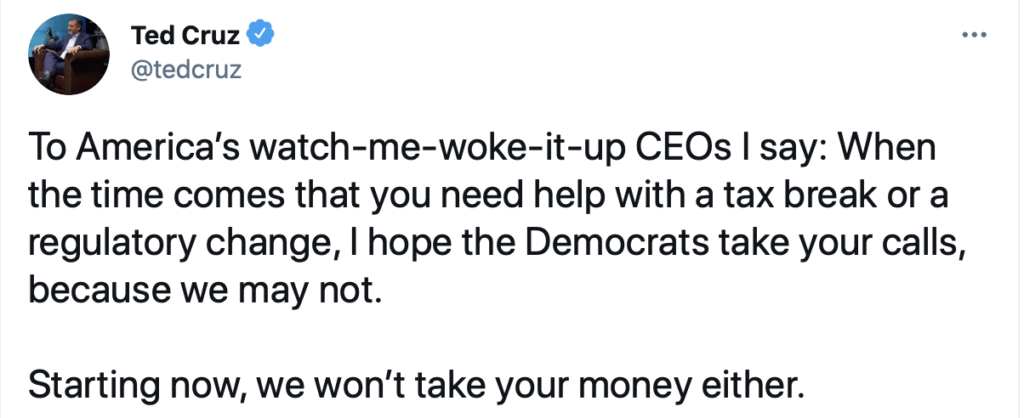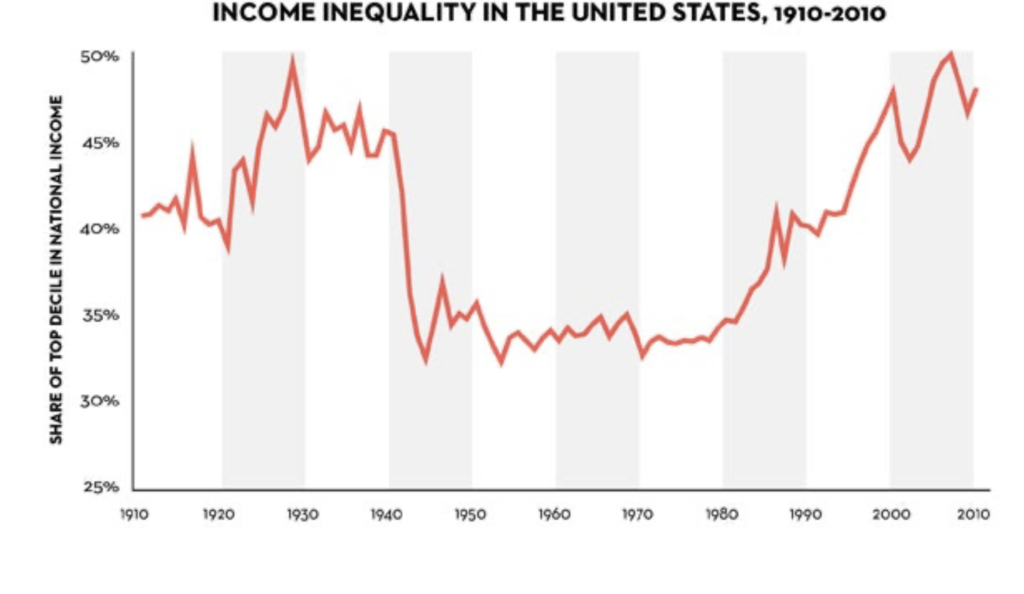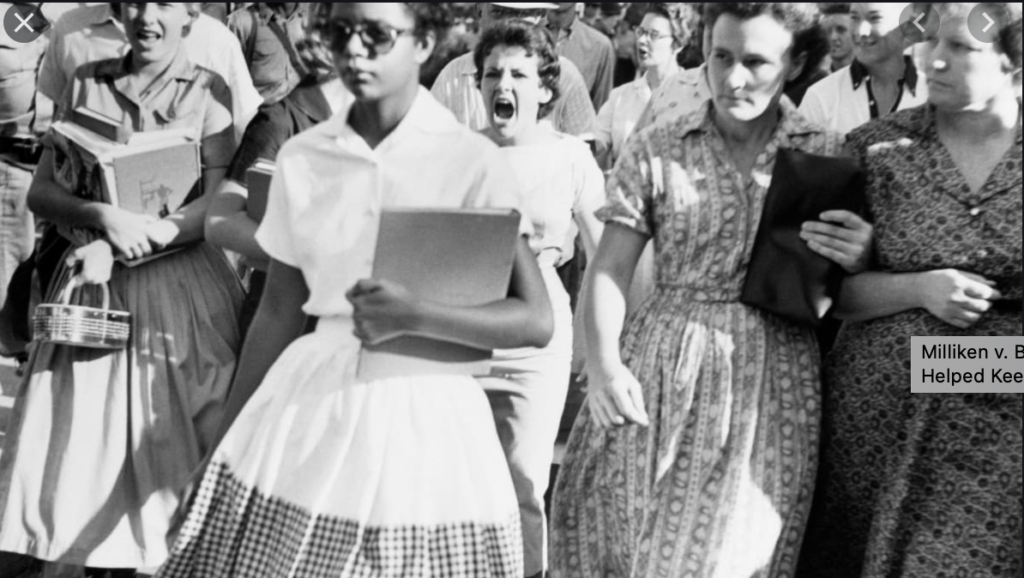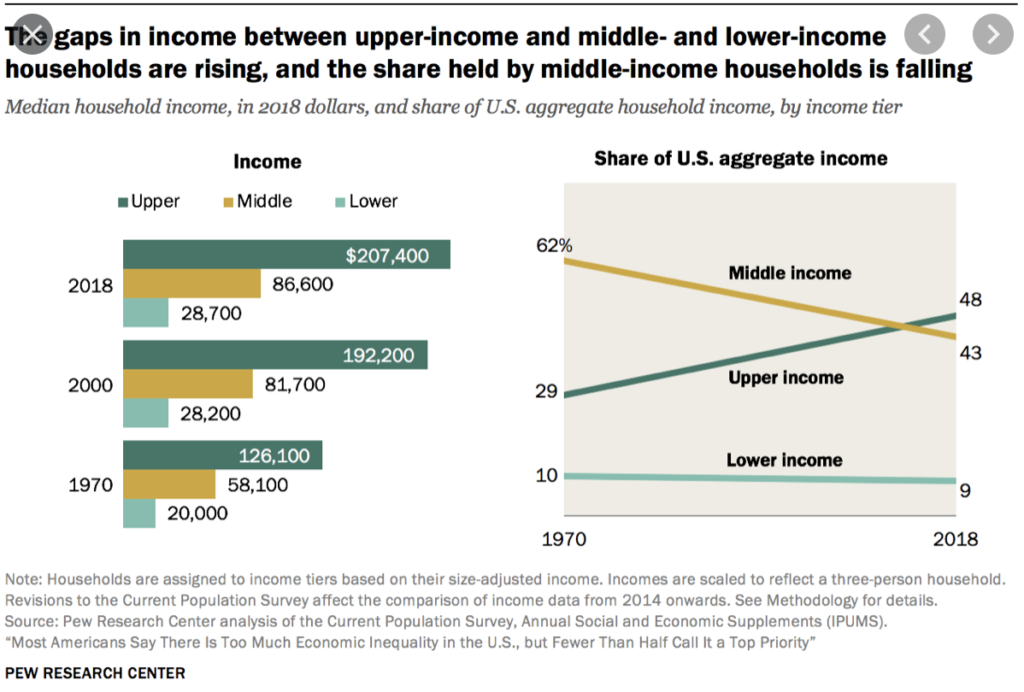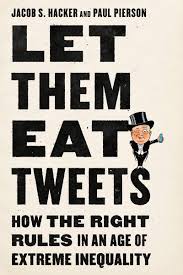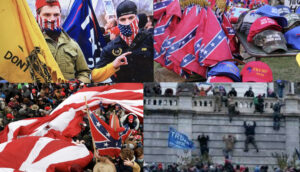This blog post started out as a YouTube video. What follows is an [edited] transcription.
A few days ago, Republican Senator Ted Cruz published an Op Ed in the Wall Street Journal, and Tweeted the conclusion:
Social media understood right away this was a stunning admission that Ted Cruz takes corporate money in exchange for doing their bidding. But of course we know that. The other reaction on social media was, “Ted Cruz turn away corporate money? Don’t make me laugh.”
There’s something else going on here which I find intriguing. I wonder: Is there a break up in the works? Are the right wing extremists and Corporate America on a verge of divorce? Is Ted Cruz singing, “You’ll be back?”
By right wing extremists, I mean these guys:
We know them. They’ve been with us since the start of the nation. 150 years ago, they supported the confederacy. 100 years ago, they supported Jim Crowe laws. 50 years ago, they felt threatened and angry when women and minorities moved into positions of power. Now they embrace QAnon. I’m also including, in right-wing extremists, people like Phyllis Schlafly, who worked hard to kill the equal rights amendment (and who, by the way, endorsed Donald Trump for president.)
We could call them reactionaries, or regressives, but given these modern images, let’s call them right wing extremists.
Before I talk about the marriage between corporate America and the right-wing extremists let’s go back to the origins of the Republican Party. At the time of the Civil War, the Democratic Party was the party of the South and the Confederacy. The Republican Party represented business and industry. (The northern economy based on industry business, the South was based on the plantation system.) The Republican Party was also the anti-slavery party. At the time these two went together: Pro-business meant anti-slavery.
When we get to the 1920s, the Republican Party still represented business and factory owners, but the Republicans by this point dropped Civil Rights from their platform. The Democratic Party was now coming to represent workers and laborers, which is kind of interesting, because they had been pro-slavery, but were now pro-worker.
This chart, put together by a group of economists and published by the New Yorker, shows the extraordinary income inequality we had in the 1920s.
The rich were very rich, and the poor were very poor, and it was hard to move up the ladder. There was basically no middle class. If you were born into a wealthy family, you could go to college because basically all it really took was money, If you were born into a poor family, it was likely you wouldn’t be able to finish high school because you had to work to survive.
In the 1920s there was no social security. There were no worker protections. If you were injured on the job and couldn’t work, you were simply left to starve. There were also very few regulations and business do what they wanted, including lots of things that are illegal today: Companies could fix prices, manipulate markets, and basically cheat in all kinds of ways.
In 1932, Franklin Delano Roosevelt, a Democrat, came to office and enacted the New Deal, which a very popular series of economic legislation. The New Deal gave us social security, protections for workers, the GI bill which offered a college education to returning soldiers and basically educated much of a generation. As a result, in the 1950s America had its first strong middle class.
There is the hitch. Blacks were left out. Racial segregation was legal. Laws kept blacks from the polls. In some places, Black who tried to vote were killed. Blacks did benefit from the New Deal, but indirectly and not to the extent that whites benefitted. Because they did benefit, at the time of Roosvelt, they began migrating from the Party of Lincoln, where they had been since the Civil War, to the Democratic Party.
The FDR era also ushered in lots of regulations for industry. These things went together: Rights for workers and regulation for industry. You can see that as a result of the New Deal, by the 1950s and 1960s, there was much less income inequality. It was also much easier for people to move up the ladder—if you were white.
Some Republicans wanted to roll back the New Deal. Some of them wanted to get rid of regulations on industry. The desire to enact policies that help the rich, by the way, is based on the idea that in a free market economy the competent people rise to the top and they deserve more money. The idea is also that If competent people are given complete freedom, they’ll create jobs and money will trickle down for everyone else. The pro-corporate policies Republicans wanted were not popular with the voters because it favored corporations and the rich, and most people were not rich.
This brings us to what political scientist and Harvard professor Daniel Ziblatt calls the “conservative dilemma,” which goes like this: Conservative economic policies are unpopular. How can a party with unpopular economic policies win national elections?
I’ve talked about 1954 as an important turning point: The Supreme Court, in Brown v. Board of Education, declared racial segregation illegal. This ignited the civil rights movement which then prompted the modern women’s movement. Then in the 1960s, Democrats like the Kennedys embraced civil rights, which helped bring about a shift in the parties. When the Democrats embraced civil rights in the 1960s, they knew they’d lose elections for a while, but they did it anyway.
Democratic Party was still the home of white Southerners, segregationalists and the KKK—but they were not feeling so comfortable anymore in the Democratic Party.
The Civil Rights movement and the anger it sparked gave the Republican corporations and business interests an idea: we can achieve electoral majorities if we invite the angry whites into our party. I mean these angry whites:
The Republicans invited them in with what has been called dog whistles. Dog whistles are racist comment that look innocuous to most people, but have a specific meaning for the intended audience. For example, on the 1980 campaign trail, Ronald Reagan gave a speech in Nashoba County, Miss., where he said this, “I believe in states’ rights … I believe we have distorted the balance of our government today by giving powers that were never intended to be given in the Constitution to that federal establishment.” He delivered the speech a few miles from the spot where three civil rights activists were shot and killed in 1964. His remarks could be taken for an innocuous statement about constitutional law. But residents of Nashoba County who sympathized with the former Confederacy and other right wing extremists understood that Reagan was signaling his agreement that the federal government overstepped its bounds when it ordered the South to desegregate. In this way Reagan could win the votes of white supremacists without offending the moderates. Keep the moderates and bring the right wing extremists into the pary.
Reagan famously described the coalition he built as described the coalition as a three-legged stool: Strong defense, limited government, and traditional values.
Let’s look closer into these “legs” because they’re dog-whistle-y. Strong defense meant anti-communism. The Soviet Union was communist and a lot of people were afraid communism was going to spread. Communism was also a buzz word to denigrate things like social security. “It’s a piece of communism!”
“Limited government” meant get rid of the New Deal and laws that regulated industry. After the Civil Rights movement, it also meant get rid of federal protections in place to protect minorities.
Traditional values means what? Sounds good, but now we know from the way Republicans behave that it doesn’t mean you can’t cheat on your wife or run around with 17 year old girls. Actually it was mostly a code phrase for women in the home. A traditional family was a place where non-heterosexuals have no place. It was anti-abortion. It therefore drew in the Religious Right (White Evangelicals).
The deal was this: We’ll appoint Supreme Court justices who will overturn Roe V. Wade, allow for discrimination against blacks, and allow local government to roll back laws that gave all people access to the polls, and in exchange, you let us give tax cuts for the rich and deregulate industry.
This marriage or coalition of pro-industry and right wing extremists worked because these groups had something in common: A hierarchical view of people. The White Supremacists and KKK believed that there is an ordering with whites at the top. The trickle-down economics people believed there is a hierarchy with the most competent at the top. The traditional family people believe there is a hierarchy with men in charge of the family.
Ronald Reagan was elected in 1980 and he immediately started deregulating industry and, you can see from the graph earlier, what happened: Income inequality started rising again and now we’re at 1920s levels (with a difference, of course; we have social security, we don’t have racial segregation, etc,
From this Pew Research Center chart, you can see that people in the upper-income brackets have increased their worth. The middle class has declined quite a bit, and lower-income families declined somewhat.
So at this point, we have a happy marriage between right wing extremists and the corporate interests. But what happened next was that the extremists in the Republican Party started growing more extreme, and the corporate guys kept going along because they were getting the economic policies they wanted.
Yale political scientist Jacob Hacker, and Berkeley political scientist Paul Pierson explain in this book how the Republican Party radicalized.
What the Republican Party leadership basically did was outsource voter mobilization to Fox News and groups like the NRA. The deal was: We’ll enact the policies you want if you send us enough voters so we can enact the economic policies we want (that favor the rich.) More and more these types were merging: People who wanted to keep whites in power also wanted to help the rich get richer.
At first, the Fox-Republican Party partnership was a boon to GOP candidates because Fox could get them elected. But outsourcing voter mobilization has drawbacks. Eventually, FOX and the NRA exerted control over Republican officials. Republican leadership was forced to cater to demands, which became more extreme over time.
Fox and the NRA backed increasingly extremists candidates, so soon the GOP leadership were these guys but dressed in suits with better haircuts:
Then along came Trump, who threw out the dog whistles. He wasn’t coy about it. He came right out and embraced white supremacists, who he called very fine people. Reagan’s dog whistles gave way to brandishing the Confederate flag.
When Trump did things like strong-arm the president of Ukraine to open an investigation into the Bidens or encourage an actual attack on Congess to overthrow an election, the Republican leadership had a choice.
They could say, Whoops, we shouldn’t have let these extremists into the Republican Party, we are going to throw them out. Some traditional conservatives, like Jennifer Rubin of The Washington Post, think that the Republican Party needs to throw the white supremacists and insurrectionists and start over, and work on persuading voters to accept their policies. But they can’t because too many members of the Republican Party (including elected officials) are right wing extremists. A recent poll showed that 30% of Republicans had a favorable view of the QAnon belief system. What are they going to do? Throw themselves out?
Meanwhile, Trump’s behavior is getting more outrageous. When he actually incited a violent insurrection against Congress to overturn an election (we’re long past dog whistles here) Republican Party had a choice: Defend Trump and the insurrection and alienate moderates, or denounce the insurrection and lose the support of the radicalized QAnon base.
Senate Minority Leader Mitch McConnell tried to walk a narrow line, as Republicans had done in the past. He nodded to the insurrectionists by voting to acquit Trump. He then tried to keep the support of moderates and corporate donors by stating immediately after the vote that Trump was “morally and practically responsible for the insurrection.”
This attempt to play both sides didn’t work. Corporations, which not only supported Republicans but were the Republican Party withdrew their support.
Instead of distancing themselves from these guys and winning back the support of moderates, McConnell pivoted to soliciting donations from individuals. He went to the grassroots, the radicalized part base. He fundraised by denouncing “cancel culture” and echoed the false claims of voter fraud. He fed these QAnon conspiracy theories. The right-wing extremist part of the base opened their wallets.
It worked. McConnell hauled in more money from these individual donors than he had in the past from his corporate donors. I put sources for these numbers here.
If the Republican leadership actually spurns corporations and turns to the right wing extremists for donations, the spiral of radicalization will continue because they’ll have to keep pleasing these QAnon types.
In light of all this, consider again Ted Cruz’s tweet and how the Republican Party has come full circle.* They started as the party of business, representing the wealthy. They brought in these extremists and white supremacists so they could get enough votes to pass an economic agenda that favors corporations. And now the extremists have taken over the party and are threatening throwing out the corporations.
What we’re seeing raises the question: Will the Republican Party, which started as the party of business and industry, jettison the industry and business portion and become purely the Party of White Grievance and extremists? This would bring the Republican Party full circle. The party that started as the anti-slavery pro-business party would end up the party of white supremacists and insurrectionists.
*A reader of this blog just pointed out (rightly) that this wasn’t a full circle! It was a 180 degree turn! (thanks)

